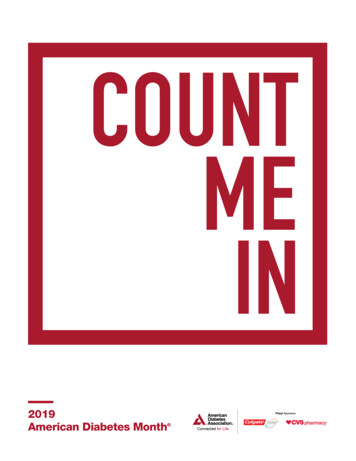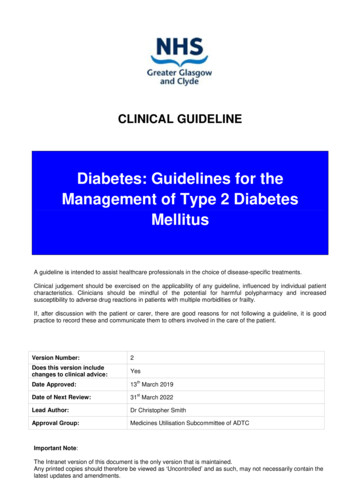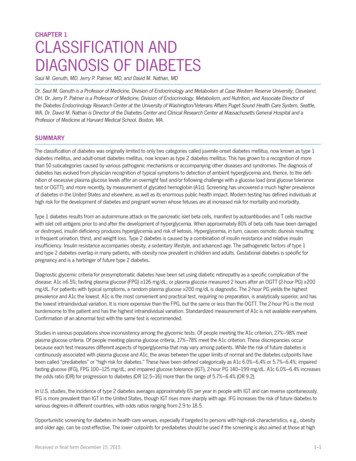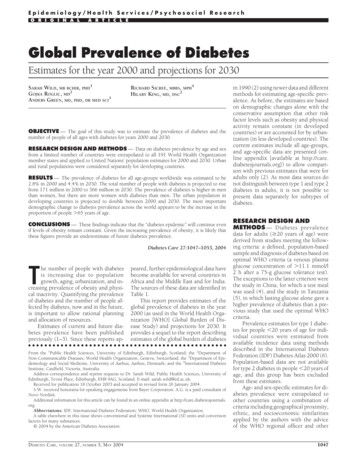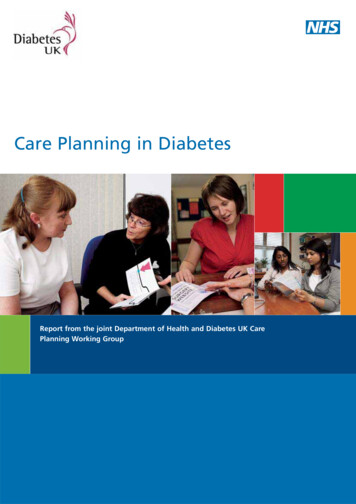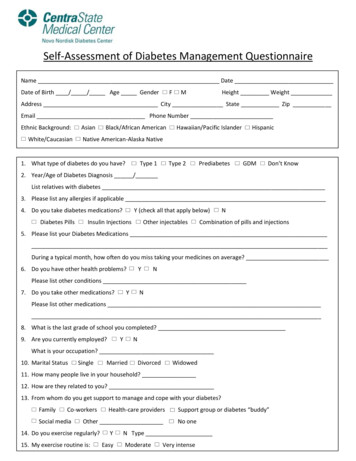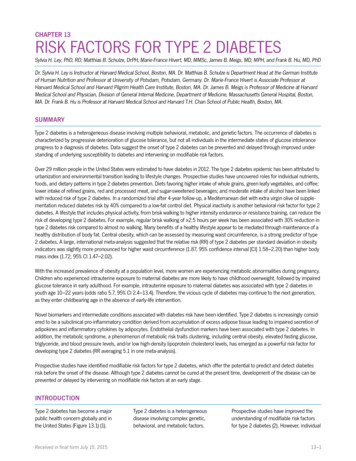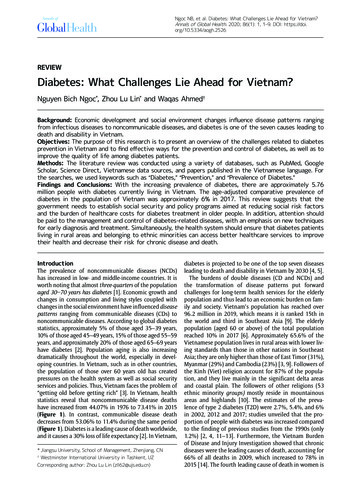
Transcription
Ngoc NB, et al. Diabetes: What Challenges Lie Ahead for Vietnam?Annals of Global Health. 2020; 86(1): 1, 1–9. DOI: https://doi.org/10.5334/aogh.2526REVIEWDiabetes: What Challenges Lie Ahead for Vietnam?Nguyen Bich Ngoc*, Zhou Lu Lin* and Waqas Ahmed†Background: Economic development and social environment changes influence disease patterns rangingfrom infectious diseases to noncommunicable diseases, and diabetes is one of the seven causes leading todeath and disability in Vietnam.Objectives: The purpose of this research is to present an overview of the challenges related to diabetesprevention in Vietnam and to find effective ways for the prevention and control of diabetes, as well as toimprove the quality of life among diabetes patients.Methods: The literature review was conducted using a variety of databases, such as PubMed, GoogleScholar, Science Direct, Vietnamese data sources, and papers published in the Vietnamese language. Forthe searches, we used keywords such as “Diabetes,” “Prevention,” and “Prevalence of Diabetes.”Findings and Conclusions: With the increasing prevalence of diabetes, there are approximately 5.76million people with diabetes currently living in Vietnam. The age-adjusted comparative prevalence ofdiabetes in the population of Vietnam was approximately 6% in 2017. This review suggests that the government needs to establish social security and policy programs aimed at reducing social risk factorsand the burden of healthcare costs for diabetes treatment in older people. In addition, attention shouldbe paid to the management and control of diabetes-related diseases, with an emphasis on new techniquesfor early diagnosis and treatment. Simultaneously, the health system should ensure that diabetes patientsliving in rural areas and belonging to ethnic minorities can access better healthcare services to improvetheir health and decrease their risk for chronic disease and death.IntroductionThe prevalence of noncommunicable diseases (NCDs)has increased in low- and middle-income countries. It isworth noting that almost three-quarters of the populationaged 30–70 years has diabetes [1]. Economic growth andchanges in consumption and living styles coupled withchanges in the social environment have influenced d iseasepatterns ranging from communicable diseases (CDs) tononcommunicable diseases. According to global diabetesstatistics, approximately 5% of those aged 35–39 years,10% of those aged 45–49 years, 15% of those aged 55–59years, and approximately 20% of those aged 65–69 yearshave diabetes [2]. Population aging is also increasingdramatically throughout the world, especially in developing countries. In Vietnam, such as in other countries,the population of those over 60 years old has created pressures on the health system as well as social securityservices and policies. Thus, Vietnam faces the problem of“getting old before getting rich” [3]. In Vietnam, healthstatistics reveal that noncommunicable disease deathshave increased from 44.07% in 1976 to 73.41% in 2015(Figure 1). In contrast, communicable disease deathdecreases from 53.06% to 11.4% during the same period(Figure 1). D iabetes is a leading cause of death worldwide,and it causes a 30% loss of life e xpectancy [2]. In Vietnam,* Jiangsu University, School of Management, Zhenjiang, CN†Westminster International University in Tashkent, UZCorresponding author: Zhou Lu Lin (zll62@ujs.edu.cn)diabetes is projected to be one of the top seven diseasesleading to death and disability in Vietnam by 2030 [4, 5].The burdens of double diseases (CD and NCDs) andthe transformation of disease patterns put forward challenges for long-term health services for the elderlypopulation and thus lead to an economic burden on family and s ociety. Vietnam’s population has reached over96.2 million in 2019, which means it is ranked 15th inthe world and third in Southeast Asia [9]. The elderlypopulation (aged 60 or above) of the total populationreached 10% in 2017 [6]. Approximately 65.6% of theVietnamese population lives in rural areas with lower living standards than those in other nations in SoutheastAsia; they are only higher than those of East Timor (31%),Myanmar (29%) and Cambodia (23%) [3, 9]. Followers ofthe Kinh (Viet) religion account for 87% of the population, and they live mainly in the significant delta areasand coastal plain. The followers of other religions (53ethnic minority groups) mostly reside in mountainousareas and highlands [10]. The estimates of the prevalence of type 2 diabetes (T2D) were 2.7%, 5.4%, and 6%in 2002, 2012 and 2017; studies unveiled that the proportion of people with diabetes was increased comparedto the finding of previous studies from the 1990s (only1.2%) [2, 4, 11–13]. Furthermore, the Vietnam Burdenof Disease and Injury Investigation showed that chronicdiseases were the leading causes of death, accounting for66% of all deaths in 2009, which increased to 78% in2015 [14]. The fourth leading cause of death in women is
Art. 1, page 2 of 9Ngoc et al: Diabetesdiabetes [14], and diabetes-related deaths doubled from2009 to 2015 (Table 1). Moreover, the risk of premature death between the ages of 30–70 years from NCDs(cancers, diabetes, cardiovascular diseases, and chronicrespiratory diseases) was 17% in 2016 [15]. Many studies have reported that in 40–73% of cases, people areunaware that they have diabetes mellitus (DM) [16, 17].The proportion of patients with undetected diabetesin the community was still very high in 2012, at 63.6%compared to 64% in 2002 [18]. It has also been reportedthat the prevalence of diabetes in urban areas is 1.68times higher than that in rural areas [17]. Accordingto the national survey from 2002–2003, the rate ofpre-diabetes was 9.2% in the country and 9.3% in themountain area [18]. Diabetes is related to the influenceof pathogenic factors such as cultural characteristics, living conditions, diet, and physical activity of each ethnicgroup [17, 19–21]. However, there have been no studiesconducted in the provinces with ethnic minorities toanalyze the incidence of diabetes among these ethnicgroups [22]. A cross-sectional study identifying the perception of and factors associated with DM showed thatparticipants aged 60–70 years were more likely to haveDM than those aged 30–39 years, and participants classified as obese were more likely to have DM than thosewith a healthy or low BMI [23]. The results of a multivariate logistic regression model unveiled the proportion ofthe Kinh ethnic group with diabetes as being 19.7 higherthan that of an ethnic minority group, and this difference was statistically significant (OR 19.7; 95% CI:1.4–283.9) [24]. Given the prevalence of diabetes amongdifferent groups of people, especially vulnerable subjects such as inhabitants of the mountainous and remoteareas, early detection is significant for the preventionand control of diabetes.Changes in Diabetes Prevention and Risk FactorsThere is a combination of genetic, physiological, environmental, and behavioral factors that encouragesdiabetes risk factors, including smoking, irrational nutrition, i nsufficient physical activity, obesity, hypertension,hyperglycemia [18].Biological/Metabolic risk factors: Obesity,Hypertension, Dyslipidemia, HyperglycemiaIn recent years, obesity has become one of the most influential contributors to T2D. Approximately 20% ofpeople who die of cancer are overweight or have high BMI(BMI 25 kg/m2) [25]. The WHO estimated that 39% ofadults aged 18 years and older were overweight in 2016,and 13% were obese [26]. According to STEPS, the prevalence of overweight among Vietnamese adults in 2015(15.6%) was almost five times that of 2000 (3.5%); the BMIamong urban populations is significantly higher than thatamong rural populations (21.3% vs. 12.6%, respectively)[20, 27, 28]. The prevalence of overweight/obesity (combined) is similar in males (33.6%) and females (31.5%) andgenerally increases with age, especially for those 50–60years of age, reaching 36.9% [29]. Assessing the overweight and obesity rates of adults aged 25–74 years (using8073.4170605044.7142.654062.4 oncommunicable Disease CasesNoncommunicable Disease DeathsCommunicable Disease CasesCommunicable Disease DeathsFigure 1: Morbidity and Mortality Trends in Vietnam during 1976–2015 (Unit: %) 6–8.Table 1: Diabetes case and diabetes-related deaths from 2009 to 2015 [39, 431,7023,2993,50927,949 54,95353,4571.Mean diabetes-related expenditure per person (20–79 years old) with diabetes (USD)2.Diabetes cases (20–79 years old) in 1000s3.Diabetes-related deaths32,5054.Adult population (20–79 years) in 1000s56,661 58,40861,387201561,697
Ngoc et al: DiabetesArt. 1, page 3 of 9Asian-specific BMI cut-offs) shows that the prevalence ofoverweight and obesity are 28.6% and 2.1%, respectively[30]. The prevalence of overweight and obesity among themountain population is 28.2% and 43.8%, respectively[21]. Based on the data, we estimated that the BMI rateincreased 1.9 times during 2000–2015 [31]. It is estimatedthat if the increase in BMI continues to follow a similartrend, then the proportion of adults being overweight willbe 21.5% by 2020 (estimated) (Figure 2). Vietnam’s obesity rate seems to have increased doubly compared to thatof other countries in the period 2000–2015; Cambodiaand India experienced an increase of 1.6 times, Indonesia’s increase was 1.77 times, and Singapore’s increase was1.1 times (Figure 2).The prevalence of hypertension reported in STEPs in2015 was significantly higher than that reported in STEPsin 2010, increasing from 15.3% (95% CI: 14.9–15.7) to20.3% (95% CI: 18.5–22.1) among the 25–64 age group[8, 20, 32]. The prevalence of high blood cholesterol( 5 mmol/L) remained high (30.2%), in 2015, with nochange from the prevalence in 2010 [18, 20]. Thus, theproportion of adults with raised blood cholesterol wouldincrease the proportion of cases at risk of NCD, particularly diabetes. Additionally, approximately 56.9% of people with hypertension and 68.9% of people with diabeteswere undiagnosed [20]. Obesity and hypertension are ofconcern due to the related increase in healthcare costs. It creates a considerable burden on both families and society to pay the health care costs related to the preventionand treatment of diabetes and other diseases.Risk behaviors: Smoking, Irrational nutrition,Insufficient physical activitytobacco use causes more than 40,000 deaths in Vietnam, which accounts for more than 100 deaths/day; thisnumber will increase to 70,000 death per year by 2030[34]. In recent years, the diabetes prevention programat the Centers for Disease Control and Prevention (CDC)has facilitated primary health care, which includes suggestions on how to empower patients, help them to takecontrol of their blood sugar and follow a self-controlleddiet [35]. However, the findings suggest that 67% of theparticipants had never heard of DM [23], and only 3.9%had a moderate or above knowledge level about the dangers and complications of the disease; additionally, only0.6% had experience with the risk factors, and 21.9% hadknowledge about the prevention and treatment of diabetes [18]. Abdominal obesity (obesity by the waist-hip ratio[WHR]) was positively associated with female gender (OR43.64, 95% CI 13.15–144.86); however, it was negativelyassociated with smokers and people aged 60 in ethnicgroups other than the Kinh and Tay religions [21]. Morethan 88% of the inhabitants disagreed with the statement that the treatment of T2D and its complicationsis not necessary [36]. This result shows that knowledgeabout diabetes and attitudes towards the condition areknown to affect compliance and play an essential role indiabetes management. In general, the experience of T2Dtreatment was significantly lower in rural areas than inurban areas [36]. In practice, some studies have shownthat the proportion of patients adhering to diabetes treatment is low at 14.2% [37]. In 2010, diabetes accounted for3% of the deaths in older adults aged approximately 70years in Vietnam [38].Irrational nutritionSmoking and Lack of knowledge about diabetesThe WHO estimates that in 2015, 20.2% of those aged 15 years for both sexes were current smokers (367 million), while the prevalence of those who smoked in Southeast Asia was 27.7% (191.8 million) [33]. Vietnam is oneof 15 countries with the highest number of tobacco usersin the world [18]. For both sexes, approximately 23.8%of the population were tobacco smokers in 2010, whichslightly decreased to 22.5% in 2015 [18]. Each year,Vietnam has the double burden of over- and undernutrition [28]. Concerning NCDs, 80.6% of people do not consume the recommended number of five servings of fruitand vegetables, and they have diets that are high in salt,fat, and sugar [39]. Studies have found that 31.3% of thetotal deaths and 25.3% of the whole disability-adjustedlife years (DALY) in Vietnam were caused by an unhealthydiet [40]. The DALY combines the estimates of years of lifelost due to premature death (YLL) and years lived in 62015Singapore2020(estimated)Viet NamFigure 2: The trend of overweight and obesity in those aged 18 years and older from 2000–2020 (Unit: %) 31.
Art. 1, page 4 of 9Ngoc et al: Diabeteshealth or with disability (YLD) to count the total years offunctional experience lost from diseases [40]. Researchershave concluded that the leading risk factor for diabetesrelated diseases is lifestyle and dietary issues [41].Physical InactivityStudies have shown that physical activity could help toprevent heart disease and diabetes, improve sleep, andlower the risk of falls, obesity, and high blood pressure inthe aging population [42]. Also, physical activity has manybenefits related to controlling blood glucose and decreasing risk factors for mortality. However, approximately3.2 million deaths and 32.1 million DALYs ( representingapproximately 2.1% of the global DALYs) are attributable to insufficient physical activity [38, 43]. The resultsfrom the 2010 STEPS survey in Vietnam showed that thepercentage of adults who got inadequate physical activity was 28.7% (26.4% for males, 30.8% for females) andthat the rate of insufficient physical activity in urbanareas was higher than that in rural areas, at 36.9% and25.1%, respectively [44]. Thus, it is imperative that morecoordinated educational campaigns and programs are30.025.020.018.616.616.028.327.327.225.524.1i mplemented, with a prioritized focus on weaker, rural,and less-educated groups [45]. From 2009–2010, morethan a quarter of the adult population was insufficientlyactive, with a more significant proportion of inactivefemales than males in the 25–64 age group [32].Only a few studies have measured the proportion ofindividuals and families that participated in regular physical exercise from 2010–2015 (Figure 3) [46]. According tothe results of the second national Survey and Assessmentof Vietnamese Youth (SAVY) in 2009, up to 23% of youthrarely or never performed physical exercises or sports,and 45% “sometimes” did so [47]. There are considerabledifferences between the prevalence of families and individuals regarding physical activity (Figure 3). More thana quarter of the adult population aged 25–64 years areinsufficiently active, with a higher proportion of inaction in females than in males (Figure 4). Figure 4 showsthat the prevalence of low physical activity for both sexeswas 28.1% in 2015. This figure was lower among males(20.2%) compared to females (35.7%) in regards of notmeeting WHO recommendations on physical activity forhealth. Thus, effective lifestyle modifications, opor on of individuals regularly par cipa ng in physical exercise(%)Propor on of families regularly par cipa ng in physical exercise (%)Figure 3: Proportion of individuals/family periodically participating in the physical activity 015MaleFemalBoth sexesFigure 4: Prevalence of low physical activity, adults aged 25–64 years (Unit: %) [18, 20, 32, 47–49].
Ngoc et al: Diabetescounseling on weight loss and the adoption of a healthydietary pattern, together with physical activity, are the cornerstones of the prevention of T2D [19]. There is a lack ofenabling environments and convenient physical facilitiesto support people in enhancing their physical exercisesto improve their health, especially in schools at differentlevels, in offices, in workplaces and in public places [18].Access to services for the prevention, diagnosis, andtreatment of diabetes is difficultHealth service delivery (HSD) is a part of the health system in which patients receive the necessary treatment andsupplies [6]. In general, primary health care practitionersin low-income countries do not possess the necessarytechnologies needed to help people with diabetes properly manage their disease. Access to essential medicines,including life-saving insulin and techniques, are limited inlow- and middle-income countries [50]. When the participation of all levels, sectors, and communities in the firstphase is limited, even within families, the patients do nothave the full awareness of the symptoms of the diseaseneeded to take actions, and this is especially true for olderadults [18]. When the management of the diabetes is leftto the sick, it creates more of a burden for the family andaffects the development of society [3].HSD includes both public and private healthcare providers in Vietnam (60% of outpatient service providers are atthe private level) [8, 51]. The communes are all located inmountainous or remote areas and are approximately 10to 40 km away from a district health center [52]. While71.6% of the population held public health insurance inVietnam by the end of 2014, many of the primary carefacilities do not possess the capacity to diagnose, treat andmonitor diabetes patients, or provide follow-up care forpatients [18].The target for the period 2016–2020 is to reach a rateof 40% CHS involved in the treatment and managementof hypertension, diabetes, and some other noncontagiousdiseases [53]. Using the fundamental technologies available in primary care facilities, blood glucose measurement,oral glucose tolerance tests, HbA1c tests, foot vibrationperception by tuning fork, and urine strips for glucose andketone measurements are not available [54]. Therefore,there is a need to significantly influence the access to anduse of health services in primary health care settings. Datafrom the National Health Survey in 2001–2002 showedthat the proportion of illnesses treated by self-medicationin the whole country accounted for 73% [55]. Meanwhile,the ability of the health system to respond is limited,especially regarding the medical examination, treatment,disease control and management of NCDs in the community, which leads to overloaded hospitals and an increasein substance use. Currently, CHSs have not met the needsof the patients. In addition to the above reasons, self-treatment is a relatively common behavior in Vietnam [18].Health ExpenditureDifferences in geographical, economic, and social conditions between the delta and mountain areas and betweenrural and urban areas, also affect the health status ofArt. 1, page 5 of 9people with diabetes [16, 17, 21]. The growing trend ofdiabetes has caused an increasing demand for medicaltreatment and treatment services at all health facilities.The cost of treating diabetes is complex and involvesmultiple factors that are higher than basic health costs,which are not affordable to poor or near-poor individuals, especially people in rural and mountain areas [56].In particular, T2D is associated with an increase in therate of chronic complications, which causes a greatdeal of damage to the human body and an individual’sphysical strength and also affects the economic development process of each country [1]. Thus, the burden ofdisease associated with diabetes is substantial; in financial terms, direct health care costs continue to increaseand are currently at 12% of the global health expenditure, while indirect damages such as the loss of production may be five times this number [39, 50]. Studies inhealth economics have also shows that even in prediabetes, patients have a high risk of developing T2D, whichincreases the cost of health care [56]. In Vietnam, thehealth expenditure per capita is 122.84 [57]. According to the International Diabetes Federation, the meandiabetes-related spending per person (aged 20–79years) with diabetes increased from 62 in 2009 to 163in 2015 (Table 1) and 217 in 2017 [2], and there areapproximately more than 5 million people with diabetesin the community, 3.5 million of whom are adults (aged20–79 years) with diabetes (Table 1) [39]. People withdiabetes are likely to seek more medical health care andaccrue more health care costs than are those without therisk of developing diabetes.Although current health expenditures tends to be lowerthan those in the past due to the policy of supportinghealth insurance for poor and near-poor individuals, thepoverty rate is likely to increase in these two groups, witha 6% rate for the near-poor population and 5.4% for thepoor population, while the rate was only 0.1% for the richand affluent during 2010 [62]. Additionally, the cost ofoutpatient treatment is much higher than that of inpatient treatment. On average, a poor household spends47.12% of their total income on diabetes, with the highest spending being related to medications [63]. Diabetesis a chronic disease that requires regular treatment, dailymedication, hospitalization, or other complications [63].Therefore, the cost of diabetes is an economic burdenon older people and their families in Vietnam. Althoughhealth insurance has significantly shared the householdcosts for diabetes-related diseases, health insurance isalso a barrier for people who participate in voluntaryinsurance.Health Systems and Healthcare Polices inVietnamThe treatment and preventive medicine systems inVietnam are multilevel under the Ministry of Health (MOH). The health system in Vietnam consists of four levels of service: central, provincial, district, and communehealth stations (CHSs) (Figure 5) [18, 20]. Additionally,there are national institutes, such as the National Institute of Nutrition and the National Institute of Hygiene
Art. 1, page 6 of 9and Epidemiology [27]. There are approximately 1,488hospitals in Vietnam, with 47 at the central level, 459 atthe provincial level and 982 district hospitals; CHSs areresponsible for providing 99% of the primary health careservices for people in the commune (Table 2), and only66% of these CHSs have a medical doctor [64].According to Decision No. 376/QĐ-TTG of the PrimeMinister, there is a need to set a target for strengtheningthe prevention, management and treatment of severalNCDs at CHSs, especially for the management of hypertension and diabetes, in an attempt to provide betterprimary care at local levels and to reduce the burden oncentral and provincial medical facilities [64]. However,public hospitals and clinics in Vietnam are frequentlyunderfunded and poorly equipped. In addition, the proportion of older adults continues to increase, leadingto the increased demand for long-term health care services [65]. Vietnam bears the double burden of disease,the aging population is rapidly increasing, and annualphysical exams are not fully covered. So the goal of theVietnamese health financing system towards universalhealth insurance is an aim of fairness, quality, and efficiency [64]. The percentage of the GDP spent on healthchanged significantly from 4.85% in 2000 to 5.66% in2016 [66]. Compared to many countries in the region,such as Malaysia (3.8% of GDP in 2016), the Philippines(3.5% of GDP in 2016), and Singapore (4.47% of GDP in2016), Vietnam’s healthcare costs are relatively high [66].The government has launched Decree 146/2018/NĐ-CP(2018) to create the best conditions for patients withchronic diseases, people with disabilities, and older persons as well as to help them seek medical services andFigure 5: Healthcare delivery in Vietnam.Ngoc et al: Diabetessave the costs of medical care and time [67]. As a result,patterns of health expenditures and financial protectionsin Vietnam from 1992–2012 show that health insurancecoverage increased from 10% in 1995 to 68.5% in 2012[68]. The government is working on improving the healthinsurance coverage, which reached 77% of the population in 2015 [6, 8, 18]. It is also focused on enhancingthe capabilities of the healthcare infrastructure andwellness rather than sickness, especially in terms of theconditions in rural areas. However, some issues negatively impact access to services, including poor equipment and the lack of essential treatment services in CHSs,which compromise the ability of governments to providehealthcare to citizens [18]. The Vietnamese governmentis making efforts to improve public healthcare in ruralareas through Project 1816 (2017), which is also known asthe satellite hospital project [18]. The aim of the satellitehospital project is that it motivates provincial-level hospitals to upgrade their infrastructure and invest in trainingmedical staff, which in turn brings benefits to patients.Table 2: Number of facilities providing health services[6–8, 48].Facilities/Year200820122017Number Number NumberCentral Level214647Provincial Level644344596221,31098210,39611,10511,120District LevelCommunal level
Ngoc et al: DiabetesConclusions and Strategies for Prevention ofDiabetes in VietnamThe results of this study provide a discussion on subjects,including high-risk factors for diabetes. Control of theprincipal risk factors, including smoking, unhealthy diets,physical inactivity, and other factors, along with activesurveillance, early detection, treatment, long-term andcontinuing management at primary health care facilities,are key measures. Therefore, there is a need to developand implement policies on risk factor prevention, suchas tobacco control policies that reduce the demand fortobacco and the management of the tobacco supply [18,34]. Policies that encourage the provision of services forthe prevention, treatment, and control of diabetes in thecommunity through family and village doctors, especiallyin mountain and rural areas, are also needed. In addition,essential medicines and testing equipment are neededto offer sufficient treatment of diabetes at CHSs. Thus,strengthening the system of examination and treatmentfacilities to provide comprehensive, advanced, and hightech services in the diagnosis and treatment of patientswith diabetes at the CHSs and district level is also needed.Vietnam is currently striving towards a universal healthcare system to decrease healthcare costs. However, theinsurance system should ensure long-term and continuing care and treatment for older individuals with diabetesin the mountain areas. Simultaneously, the health system should ensure that diabetes patients living in ruralareas and belonging to ethnic minorities can access betterhealthcare services to improve their health and decreasetheir risk for chronic disease and death. Therefore, futurestudies need to consider access to healthcare and the quality of life of people with diabetes and promote the role offamilies in the management, care, prevention, and education related to diabetes.AcknowledgementsI want to express my sincere thanks to my supervisor, whois always welcoming, who helped me find a good topicto research, and who has support for my research in thefuture.Funding InformationThis research did not receive any specific grant from funding agencies in the public, commercial, or not-for-profitsectors.Competing InterestsThe authors have no competing interests to declare.References1. Ogurtsova K, da Rocha Fernandes JD, HuangY, et al. IDF Diabetes Atlas: Global estimates forthe prevalence of diabetes for 2015 and 2040.Diabetes Research and Clinical Practice. 2017;128: 40–50. DOI: https://doi.org/10.1016/j.diabres.2017.03.0242. International Diabetes Federation. Diabetesatlas. Eighth edition 2017. International DiabetesFederation; 2017, 126.Art. 1, page 7 of 93. United Nations Population Fund (UNFPA). Theageing population in Viet Nam: Current status,prognosis, and possible policy responses. VIET NAM;2011.4. Institute of Health Metrics and Evaluation. Vietnam. 2017. Available from: http://www.healthdata.org/vietnam. Accessed November 15, 2019.5. Mathers CD and Loncar D. Projections of globalmortality and burden of disease from 2002 to 2030.PLoS Med. 2006; 3(11): e442. DOI: https://doi.org/10.1371/journal.pmed.00304426. Ministry of Health. Health statistics yearbook.2017.7. Ministry of Health. Health statistics yearbook.2011.8. Ministry of Health. Health statistics yearbook.2015.9. General Statistics Officce of Viet Nam. Prelimi nary result of Vietnam population and housing cen sus 2019. Ha Noi; 2019.10. Bivens L. Basis health care series: Diabetes. AlphaEditions; 2017.11. Quoc PS, Charles MA, Cuong NH, et al. Bloodglucose distribution and prevalence of diabetesin Hanoi (Vietnam). Am Journal Epidemiol. 1994;139(7): 713–22. DOI: 12. Nguyen CT, Pham NM, Lee AH and Binns CW. Prevalence of and risk factors for type 2 diabetesmellitus in vietnam: A systematic review. Asia PacJounal Public Health. 2015; 27(6): 588–600. DOI:https://doi.org/10.1177/101053951559586013. International Diabetes Federation. Diabetesprevalence (% of population ages 20 to 79). 2017.Available from: S. Accessed November 15,2019.14. Trang Nhung NT, Khanh Long T, Ngoc Linh B, VosT, Duc Anh N and
Diabetes: What Challenges Lie Ahead for Vietnam? Nguyen Bich Ngoc*, Zhou Lu Lin* and Waqas Ahmed† Background: Economic development and social environment changes influence disease patterns ranging from infectious diseases to noncommunicable diseases, and diabetes is one of the
